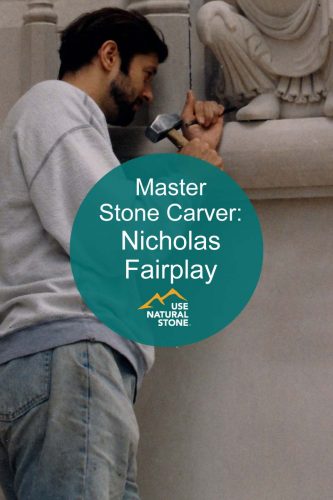Beyond Beauty: Creating Timeless Spaces with Sustainable Natural Stone
Natural stone is often chosen for residential and commercial work because of its beauty and versatility. It’s also really nuanced, according to Roger P. Jackson, FAIA, LEED AP, a senior principal and past president of FFKR Architects, a Salt Lake City, Utah-based full-service architecture firm that serves clients primarily in its headquarter city and Scottsdale, Arizona.
Jackson mostly uses granite for his architectural projects, although he’s also worked with limestone. He is drawn to the beauty of natural stone and believes that its beauty goes beyond aesthetics. “Natural stone feels more durable,” Jackson says. “It has a character of strength, stability, durability, and mobility.”
While other materials may be durable, Jackson notes that natural stone in particular has history, character, and feels good to the touch. It can be carved, and texture can be added to many types of stone, adding another level of interest. Texture is often something he’s seeking when designing buildings.
Jackson credits his clients who understand and appreciate the strength and beauty of natural stone and are willing to invest in it. As a result, he’s been able to incorporate some truly remarkable natural stone into his projects.
Why temples and religious institutions request natural stone
FFKR Architects created an entire division within their firm to manage their work with specialized buildings such as religious institutions. The firm often works on temple buildings and special projects for the Church of Jesus Christ of Latter-day Saints and these properties often have unique complexities. While their work in this space began more than three decades ago with the upgrade and extensive remodel work on the Hotel Utah Building when it was converted into the Joseph Smith Memorial Building, its architects have since designed new temples in cities across the United States and completed remodeling projects on historic church buildings including temples and the Tabernacle on Temple Square in Salt Lake City.
Jackson is one of the architects who directs the Religious Studio. According to Jackson, the Church of Jesus Christ of Latter-day Saints likes to build their buildings out of noble and enduring materials that truly stand the test of time. “They want to build out of long term materials,” he adds, noting they are looking at investments in their buildings that can last 1,000 years. Interiors can be more flexible so they can be remodeled as necessary, but the exteriors are requested to be noble, rich, and beautiful.
Natural stone is often chosen for these reasons.
Philadelphia Pennsylvania Temple: Choosing the right stone for the project
One of Jackson’s most recent projects was the Philadelphia Pennsylvania Temple, which features Deer Isle granite from a quarry in Maine. “It’s this beautiful, kind of medium gray stone that has a little bit of a lavender cast to it,” he explains. “It looks beautiful when it’s dry. It looks beautiful when it’s wet. It’s one of my favorite stones because it’s really quite unique.”
Many buildings throughout the East Coast are built using this particular stone. There were many reasons why this stone stood out for him and his team to use for this project.
First, many of the stone buildings in Philadelphia feature a grayish granite. Right across the street is the Cathedral Basilica of Saints Peter and Paul, which Jackson describes as a fabulous and beautiful building but kind of a brownstone, which is more of a sandstone or a rusty chocolate rich brown. By choosing Deer Isle granite, the Philadelphia Pennsylvania Temple would match more of the buildings in town and not compete with or match the Catholic cathedral across the street.
Adjacent to the temple are two historic Renaissance Revival icons – the Philadelphia Free Library and the Family Courts Building. The temple is a wonderful addition to the historic Logan Square – one of the five original squares planned for Philadelphia by William Penn.
Secondly and importantly, Deer Isle granite passed the technical and compression testing that would allow it to hold up for centuries to come with flying colors. Some of the technical testing it underwent, according to Jackson, focused on its strength. “How strong is the stone, how much does it weigh when it’s wet, and how saturated can it get? What is its freeze thaw? You run it through, you soak it, freeze it hard, thaw it out, soak it, freeze it,” and they’d repeat the cycle over the course of months specified by the testing requirements.
Finally, the building is clad in cut natural stone and highly detailed in the Neoclassical revival style of American Georgian architecture. The granite was flexible to be carved and textured, even if it wouldn’t be as visible from 200 feet above ground.
“One common cost-cutting feature is the higher up you get, the more dumbed down the details and the carvings,” Jackson says when it comes to building with natural stone. “We did not do that. We knew people would be looking at this building up close.”
Jackson says the Philadelphia Pennsylvania Temple is a spectacular building in the city and one of his favorite projects.
Natural stone has timeless character
Jackson loves using natural stone for projects and there is another type of stone he’s hoping to be able to use for a project soon: Moleanos, a Portuguese limestone that he says features a beautiful creamy color: “Orange and creamy as opposed to yellow.”
Until then, he’ll continue to reach for the best natural stone for each project because he insists stone has timeless character that never goes out of style. He points to most ancient buildings that still stand tall today because they were built with stone.
“Natural stone has this timeless look whether you carve it, shape it to match a historic classical precedent, or you cut big fat slabs and build with big pieces,” he says.
He looks at the some of the buildings being built today that are more modern or contemporary and while he admits he’s more of a classical and traditional architect, architects and project managers are drawn to natural stone for similar reasons: they want that richness of color and a material with natural character and the timelessness that natural stone provides.
“Natural stone is not going to go away until you carry it away,” Jackson says.








